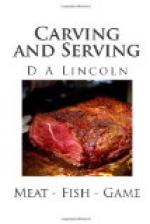By filling the cavity again with stuffing, a ham may be served as a whole one the third time and look as inviting as when first served. Should there be two or three inches of the thickest end left for another serving, saw off the bone, lay the meat flesh side up, with the fat on the further side of the platter, and carve horizontally in thin slices.
TONGUE.
The centre of the tongue is the choicest portion. Cut across in slices as thin as a wafer. The tip of the tongue is more delicate when cut lengthwise in thin slices, though this is not the usual practice.
CORNED BEEF.
Corned beef should be put while hot into a pan or mould, in layers of fat and lean, with the fibres running the long way of the pan. After pressing it, place it on the platter and slice thinly from one end. This gives uniform slices, cut across the grain, each one having a fair proportion of fat and lean.
CHARTREUSE, OR PRESSED MEAT.
Any moulds of meat, either plain or in jelly or rice, should be cut from one end, or in the middle and toward either end, in uniform slices, the thickness varying with the kind of meat. Be careful not to break them in serving. If only a part of a slice be desired, divide it neatly. Help also to the rice or jelly.
TO CUT UP A CHICKEN FOR A STEW OR FRICASSEE.
Nothing is more unsightly and unappetizing than a portion of chicken with the bones chopped at all sorts of angles, and with splinters of bone in the meat. All bones will separate easily at the joint when the cord or tendon and gristly portion connecting them have been cut.
After the chicken has been singed and wiped, and the crop removed from the end of the neck, place it in front of you with the breast up and the neck at the left. With a small sharp knife make an incision in the thin skin between the inside of the legs and the body. Cut through the skin only, down toward the right side of the leg, and then on the left. Bend the leg over toward you, and you will see where the flesh joins the body and also where the joint is, for the bone will move in the joint. Cut through the flesh close to the body, first on the right of the joint and then on the left, and as you bend the leg over, cut the cord and gristle in the joint, and this will free the leg from the body. Find the joint in the leg and divide it neatly. Work the wing until you see where the joint is, then cut through the flesh on the shoulder, bend the wing up and cut down through the gristle and cord. Make a straight clean cut, leaving no jagged edges. Divide the wing in the joint, and then remove the leg and wing from the opposite side, and divide in the same way. Make an incision in the skin near the vent, cut through the membrane lying between the




